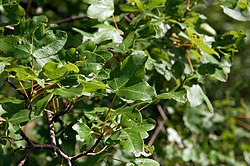| Habit | tree
| |
|---|---|---|
| Height: | ⇕ | 40 ft"ft" can not be assigned to a declared number type with value 40. |
| Width: | ⇔ | 35 ft"ft" can not be assigned to a declared number type with value 35. |
| Lifespan: | ⌛ | perennial |
| Bloom: | ❀ | early spring, mid spring, late spring |
| Exposure: | ☼ | sun |
|---|---|---|
| Features: | ✓ | deciduous, flowers, bonsai, fall color |
| USDA Zones: | 6 to 8 |
|
Acer > |
Montpellier Maple (Acer monspessulanum) is a species of maple native to the Mediterranean region from Morocco and Portugal in the west, to Turkey and Lebanon in the east, and north to the Jura Mountains in France and the Eifel in Germany.[1][2][3]
It is a medium-sized deciduous tree or densely-branched shrub that grows to a height of 10-15 m (rarely to 20 m)[4]. The trunk is up to 75 cm diameter, with smooth, dark grey bark on young trees, becoming finely fissured on old trees. Among similar maples is most easily distinguished by its small three-lobed leaves, 3-6 cm long and 3-7 cm wide, glossy dark green, sometimes a bit leathery, and with a smooth margin, with a 2-5 cm petiole. The leaves fall very late in autumn, typically in November. The flowers are produced in spring, in pendulous, yellow to white corymbs 2-3 cm long. The samaras are 2-3 cm long with rounded nutlets.[2][3]
It is variable, and a number of subspecies and varieties have been described, but few are widely accepted as distinct. The most widely accepted as distinct is Acer monspessulanum subsp. microphyllum (Boiss.) Bornmueller, from Turkey and Lebanon, with smaller leaves not over 3 cm broad.[2]
The species can be mistaken for Acer campestre (Field Maple), another maple native to Europe, from which it is best distinguished by the clear sap in the leaves (milk-white in Field Maple), and the much narrower angle between the samara wings.[2][3]
Among maples not endemic to Japan, A. monspessulanum (and the similar A. campestre) are popular among bonsai enthusiasts.[5] In both cases, the smallish leaves and shrubby habit of the maple respond well to techniques to encourage leaf reduction and ramification.[6] These bonsai have an appearance distinct from those created from maples such as Acer palmatum whose leaves are more more frilly and translucent.
Otherwise, Acer monspessulanum is rarely seen in cultivation outside of arboreta.
Read about Acer monspessulanum in the Standard Cyclopedia of Horticulture
|
|---|
|
Acer monspessulanum, Linn. (syn. A. trilobatum, Lam.). Shrub or small tree, 25 ft.: lvs. 3-lobed, coriaceous, 1-3 in. across, shining above, glaucous and glabrous beneath; lobes entire or with few obtuse teeth: corymbs erect: fr. with slightly spreading wings. S. Eu., N. Afr., W. Asia.—Shrub or small tree of slow growth, with a dense, rounded head and, in temperate regions, nearly evergreen foliage, thriving well in dry situations. Var. ibericum, Koch. (A. ibbricum, Bieb.). Lvs. larger, the inner lobes usually slightly 3-lobed, obtuse. CH
|
Cultivation
Propagation
Pests and diseases
Varieties
Gallery
References
- ↑ Flora Europaea: Acer monspessulanum
- ↑ 2.0 2.1 2.2 2.3 Rushforth, K. D. (1999). Trees of Britain and Europe. ISBN 0-00-220013-9.
- ↑ 3.0 3.1 3.2 van Gelderen, C.J. & van Gelderen, D.M. (1999). Maples for Gardens: A Color Encyclopedia.
- ↑ Template:Fr iconFleurs de France: Acer monspessulanum
- ↑ Bonsai Club International: Acer monspessulanum
- ↑ Bonsai Club International: Acer campestre
External links
- w:Acer monspessulanum. Some of the material on this page may be from Wikipedia, under the Creative Commons license.
- Acer monspessulanum QR Code (Size 50, 100, 200, 500)

